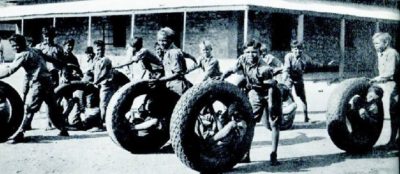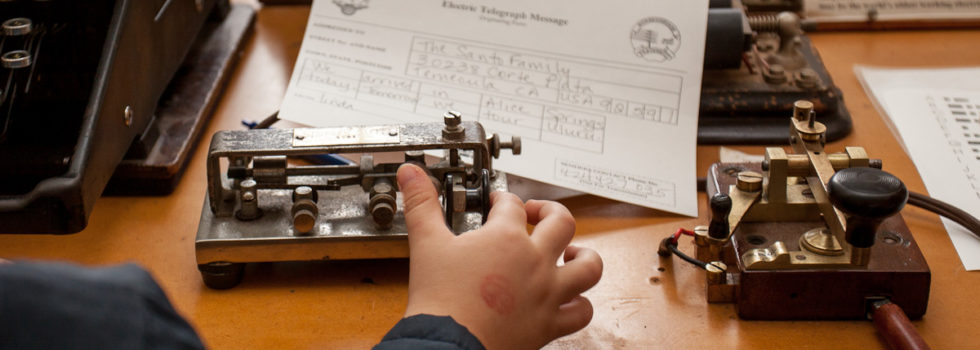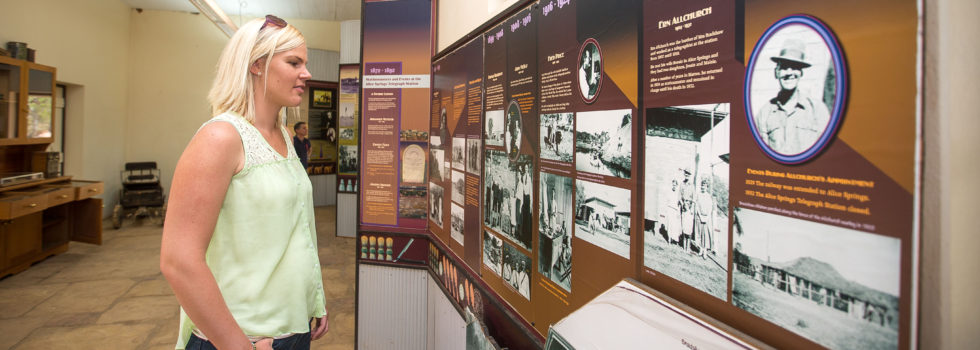The birthplace and history of Alice Springs
A visit to the Historical Precinct is the best way to immerse yourself in the history of the Alice Springs Telegraph Station. Discover the origin of Alice Springs as a town and its interesting characters throughout its history. But here is a little snippet of what you will learn when you come and see us….
Arrente Country
For thousands of years Arrente people met in what we now know as Alice Springs for ceremonies and to exchange goods. The Arrente word for this place is Mparntwe.
An End to Silence

Linesman, Alice Springs Telegraph Station
In July 1862 explorer John McDouall Stuart led an expedition (his third and final attempt) through the Centre of Australia. Travelling to the north coast, he was navigating and mapping the country for European settlement. He survived where the likes of Leichhardt and Burke & Wills perished, because he studied how the aboriginal people lived and was able to travel much lighter and faster, foraging for food and digging for water rather than trying to drag tonnes of supplies through the desert. As arguably Australia’s pre-eminent explorer, the Stuart Highway now honours his remarkable feats of exploration and leadership.
Following in Stuart’s footsteps, the South Australian government allocated $250,000 for the construction of an Overland Telegraph Line in October 1870. The line was to extend from Port Augusta in South Australia, to Palmerston (now Darwin), a route closely following that of McDouall Stuart to make use of the water supplies he mapped out along the way. Construction of the Overland Telegraph line began in early 1871, involving around 500 men split into three sections. In December of that year, the first Morse signals were sent along the completed southern section of the line. However, the northern team encountered a violent monsoon that summer which washed away more than a thousand of the telegraph poles they planted, and cut them off from resupply until Todd was able to get a barge up the flooded roper river to rescue them. The north and central sections of the line were eventually joined on August 22nd, 1872 at Frew Ponds, near Dunmarra. Unfortunately there were problems with the undersea cable linking Palmerston with Java that were not resolved until October.
The final cost of the line was nearer twice the original estimate, but the prestige for South Australia was immense. It was truly one of the great engineering feats of the 19th century!
The Telegraph Station
Becoming the centre of activity in the area, outbuildings were gradually added to the Telegraph Station. These included policemen’s quarters, harness and buggy sheds, a Stationmasters residence, a battery room, blacksmith’s shop and a kitchen-mess room.

The Kitchen, Alice Springs Telegraph Station
Like the original Telegraph Station these were all built with local stone and lime mortar. They then had thatched rooves which were later replaced with galvanised iron.
The Telegraph Station operated 24 hours a day and was one of 12 along the 3,000 km line. It was basically self-sufficient, relying on provisions from the south only once a year. Sheep, goats, cattle and their own vegetable garden ensured adequate food and the blacksmith made much of their equipment.
The first Stationmaster was Johannes Mueller (1872-1879). Four telegraphist-linesmen, a teacher-governess, a cook, and a stockman-blacksmith made up the rest of the staff.
More modern facilities were then established in the new township of Stuart in 1932 (Corner of Railway Tce and Parson Street) and the Telegraph Station ceased operation. The Post Office in Hartley Street (across from the Yeperenye shopping centre) has since replaced this facility.
The Bungalow
After ceasing operation as a telegraph station, the site was converted into what was nominally an education facility for mixed race children, called the Bungalow. In reality, many of the children there were taken by force from their aboriginal mothers, which is why the Bungalow is also referred to as a Stolen Generation site.
In 1942, when Alice Springs became an army base following the bombing of Darwin in World War 2, the children here were evacuated from the Bungalow. After the war, the site reverted to Arrernte control, until in 1963 the aboriginal people moved to Amoonguna, an aboriginal settlement south-east of town. This settlement still exists today. The old Telegraph Station site was then gazetted as an historical reserve.

The Bungalow children’s home, Alice Springs Telegraph Station 1932-1960
The Historical Reserve
The then Northern Territory Reserves Board (now Parks and Wildlife Commission NT) began a program of reconstruction of the old buildings in the late 1960s. Using old photographs of the settlement at the turn of the century resulted in a restoration of the buildings and area as it looked between 1895 and 1905.
So who WAS Alice?

Sir Charles and Mrs Alice Todd
The Alice Springs settlement was named after Mrs Alice Todd. Alice was the wife of Charles Todd, who won the government tender to construct the Overland Telegraph line. Telegraph line surveyor Mr William Mills was seeking a suitable location for a repeater station ahead of its construction. Mills came across a mighty inland river system (usually dry) he named after his boss Charles Todd. He then came across what he thought was a natural spring in the river system. A location with a water supply was a good location for the repeater station. He named and mapped the site of Alice Springs for the construction party. Sadly there was never a natural spring in the river. It was actually a water hole from after the river had once flowed, then left in the usually dry river system.
Former Bungalow resident and Tour Guide Alec Ross OAM explains the history, heritage and life at the Telegraph Station.





